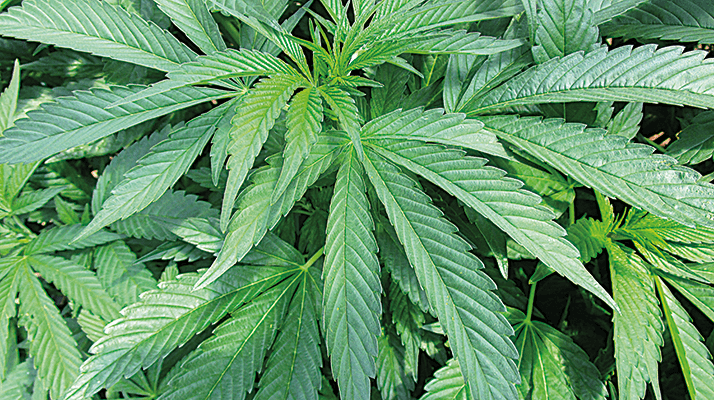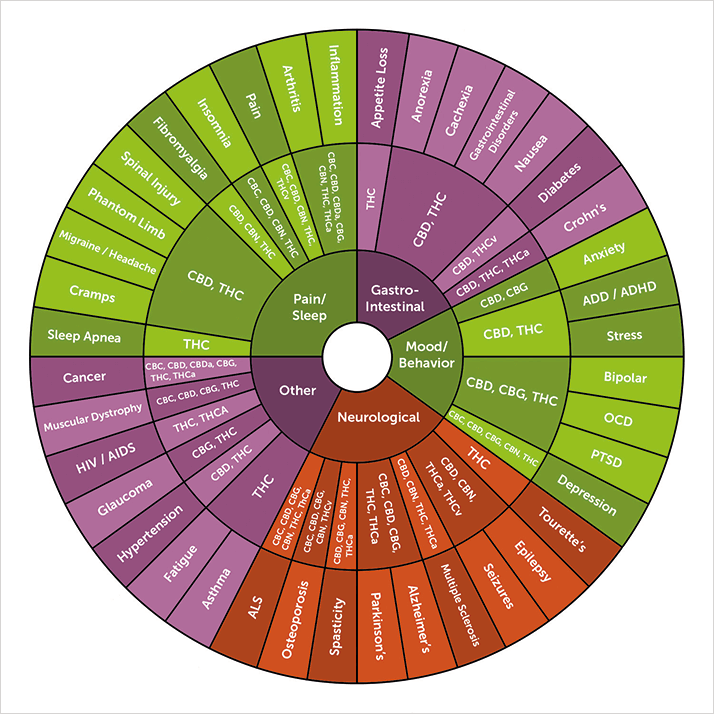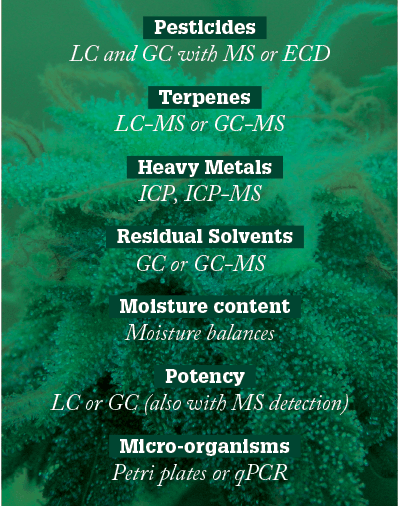
The cannabis plant contains more than 500 unique compounds; we have a long way to go before understanding the health benefits of all of them (see Figure 1) – or appreciating the synergies between cannabinoids, terpenoids and flavonoids. For more than 80 years, cannabis chemistry has been suppressed, and the industry itself needs to recover. In the USA, there are currently 24 states (and the District of Columbia) that have legalized medical marijuana and another four states that have legalized recreational marijuana. The analytical upshot? Cannabis sold for either medicinal or recreational use needs testing for potency and to reduce the risk of contamination. Indeed, cannabis-testing laboratories are sprouting up across the USA; they are vital to accurate cannabis product labeling, as well as cannabis quality control. Cannabis testing also serves to determine peak harvesting times for growing operations.

The important psychoactive component in marijuana is tetrahydrocannabinol (THC), making it the primary focus of potency testing. Natural Cannabis plant material contains THC-A, the non-psychoactive, carboxylic acid form of THC. Since THC-A is converted to THC upon heating, high-performance liquid chromatography (HPLC) is the method of choice for testing because it can distinguish THC from THC-A. Gas chromatography (GC) can also determine total THC. A big challenge in potency testing is the complexity of the cannabinome; there are at least 80 cannabinoids present in cannabis, each with unique therapeutic properties (1). Most cannabis analytical testing, however, includes values for less than a dozen cannabinoids. Cannabidiol (CBD) – another major component of cannabis (2) – is a phytocannabinoid that accounts for 35 to 40 percent of cannabis extracts. THC-A, THC and CBD, cannabidiolic acid (CBDA), cannabigerolic acid (CBGA), cannabigerol (CBG), cannabinol (CBN), Δ9-tethrahydrocannibinol (Δ9-THC), Δ9-tethrahydrocannibinolic acid (Δ9-THCA) and cannabichromene (CBC) are commonly measured cannabinoid (CBx) profiles. These cannabinoids are all separated and analyzed using conventional HPLC (not UHPLC) in under two minutes (3). More work is needed to develop analytical conditions for rapid and accurate separation and detection of the 70-plus other cannabinoids.
Smoking dried plant material is the most common technique for taking cannabis. However, the growing use vaporizers, together with the market in electronic cigarettes, means the demand for “vaping” oils has exploded. There are various ways to extract cannabis oil from dry products. For example, a highly concentrated form of cannabis oil utilizes butane as an extraction solvent (butane hash oil or BHO). Heptane, propane, glycerin, and ethanol, and even rubbing alcohol, have been used to extract cannabis oil. This is clearly a concern and, in May 2014, the state of Colorado issued a new regulation requiring all solvent-extracted cannabis concentrates to be tested for residual solvents. Another, safer form of hydrocarbon extraction is CO2 (gas or liquid) extraction. Yet another method involves fat-based concentrates using infused butters or edible cooking oils. In addition to their use in vaping oils, cannabis concentrates play a very important role in a fast-growing edible industry. Concentrated oils and butters are applied to a wide variety of cannabis edibles, ranging from beverages and confectionery to pizza (4). And the majority of medical marijuana patients prefer edibles and sublingual drops over smoking. Sublingual dosing ensures that maximum natural cannabinoids, including THC-A, are bioavailable; potency testing is important to ensure accurate dosing.
In addition to cannabis potency profiles, cannabis testing also identifies a wide variety of contaminants, such as residual solvents, pesticides, microorganisms, mycotoxins (such as aflatoxin) and heavy metals. Such contaminants are especially troublesome to medical marijuana patients with compromised immune systems Residual solvent testing is performed commonly with headspace GC-MS, which is similar to US Pharmacopeial Convention “USP <467> for Residual Solvents”. The enormous number of pesticides available makes it impossible to test for all of them , but one again GC-MS is the preferred instrumentation platform for pesticide residue testing. GC-MS instruments with twin-line capabilities allow labs to run residual solvent (or terpene) analyses on the same instrument as pesticides. While there are currently no guidelines for residual pesticide screening in cannabis, most labs test for the most common pesticides employed during cannabis cultivation: organophosphates, carbamates, pyrethroids and avermectins. MRX Labs in Portland, Oregon, USA, is leading the way in pesticide analytical testing services, offering a panel of 40 pesticides.
The ideal conditions for cannabis growth are also ideal for the growth of potentially harmful bacteria and fungi including yeast and molds, therefore microbial contamination poses health risks to consumers and immunocompromised individuals. Microorganisms are monitored using analytical techniques ranging from simple petri film tests to genomics testing. Quantitative polymerase chain reaction (qPCR) will likely replace the current practice of testing for molds and bacteria using petri dishes. Matrix-assisted laser desorption/ionization (MALDI) microorganism identification is commonplace for clinical microbiology and could be used as a qualitative technique to certify the presence or absence of various microorganisms in cannabis samples. MALDI could also compete with genomics testing for cannabis strain typing. And mycotoxins can be detected using LC-MS/MS. Finally, heavy metals (lead, mercury, cadmium, and arsenic), can be tested by atomic absorption, inductively coupled plasma ICP-MS.
Terpenes are a very important class of cannabis compounds and are analyzed using headspace GC-MS. They are produced in cannabis trichromes (as is THC) and give cannabis its distinctive flavor and aroma. Terpenes also act as essential, medicinal hydrocarbon building blocks, influencing the overall therapeutic effect. The roles of terpenes in personalized therapies is becoming increasingly important (see Figure 2). For example, pinene acts as a bronchodilator, increasing THC absorption. Linalool can impart sedative effects, and limonene, like most terpenes, has its own therapeutic effects. It is likely that flavonoids will also play an increasingly important role in understanding cannabinoid synergies and the therapeutic effects of cannabis.

The analytical techniques used in cannabis testing (Figure 3), have a long history of application in clinical, pharmaceutical, food safety and environmental markets. Analytical instrument manufacturers are, therefore, assisting cannabis testing laboratories with sample preparation protocols, method development and establishing good laboratory practices (GLP) to ensure that they meet or exceed state laws for environmental and food safety testing laboratories. Whereas established industries have longstanding guidelines and standards, the cannabis industry is feeling its way as it develops.

Consequently, there is a widespread lack of standards, reference materials, proficiency testing and laboratory certification. There are, however, experienced laboratory directors with analytical, sample preparation and data processing skills, who are interacting and beginning to develop cannabis testing quality standards.
Although marijuana has been legalized by several states, it has yet to be legally recognized by the US federal government. Since there are no US Food and Drug Administration (FDA) criteria for cannabis testing, individual states have had to establish regulations on their own. The FDA has recently ruled that cannabidiol products don’t fit under the legal definition of dietary supplements and therefore can’t be marketed as such under the federal Food, Drug and Cosmetic Act (5).
The next frontier for cannabis analytical testing resides in personalized cannabinomics. Ken and Melodie Kovash operate a biomedical farm in Oregon (GI Grow – www.gigrow.us) in accordance with Oregon Medical Marijuana Program rules; they are pioneering a personalized cannaceutical approach. The company has a holistic approach to cannaceutical development, focusing on quality rather than yield, to produce blends of CBx oils in response to patient outcomes and tailoring personalized cannabinomics strategies for each individual patient. Cannabis produces different chemicals due to multiple environmental/physical stresses and needs. As we learn more about the health benefits of cannabis, we must gain a much better understanding of the synergies of cannabinoids, terpenes and flavonoids. This represents a great opportunity for analytical chemists; the potential to understand and unlock the interactions of cannabinomics on a larger, disease-specific scale. Taking it a step further, fine-tuning of cannabis components for maximum therapeutic effect requires more research and analytical testing.
Additional opportunities exist in developing automated sample preparation and analytical testing methods. Technologies like online SFE-SFC-MS/MS integrated with LC and MS address cannabis sampling deficiencies, allowing fully automated extraction, separation and detection of all components in cannabis. As the need for better quality control continues and standardization is introduced in this emergent industry and market, lower limits for the various cannabis contaminants will be established and regulations will be introduced. Mass spectrometry will play a greater role in quantitation as detection levels are lowered and confirmatory tests are required. With an increase in cannabis consumption comes an increase in public safety concerns, such as drugged driving. Law enforcement authorities need new, low-cost methods for rapid salivary, breath-based and/or finger-stick screening of individuals that appear to be under the influence of marijuana. Also, better product packaging and labeling is needed to reduce accidental infant exposures, especially for confectionery-like, medicinal marijuana edibles. One particular difficult challenge in cannabis testing for public and workplace safety is the need to identify better biomarkers that indicate accurate timelines of cannabis exposure. Currently, it is difficult to distinguish between recent cannabis usage and long term, chronic marijuana exposure. A stronger integration between testing labs and growing operations, extraction operations, dispensaries, customers, clinical labs and physicians will ensure that cannabis product information is accurate and more readily available. Meanwhile, cloud technology and vertical supply chain integration can improve operational efficiency. All-in-one business management software solutions, such as those provided by Viridian Sciences (Vancouver, Washington, USA) enable ‘cannabusiness’ to run efficiently with automated inventory tracking, seed-to-sale reporting, financial accounting, management, and quality control.
Cannabis testing is not just a growing US market. Sativex – a synthetic, pharmaceutical version of cannabis – has been approved for use in 25 countries as a treatment for muscle spasm pain in multiple sclerosis patients. Marinol (a synthetic THC product) has been FDA approved to treat nausea and vomiting associated with cancer chemotherapy in patients who have failed to respond adequately to conventional treatments. The FDA also approved Marinol to treat appetite loss associated with weight loss in people with AIDS. Idrasil is a physician prescribed “medical cannabis in a pill”. Unlike Marinol, Idrasil is an all-natural cannabis plant extract containing the full spectrum of naturally occurring cannabinoids from cannabis. As more cannabis-based or synthetic cannabinoid drugs and homeopathic medicines enter the marketplace, and as more states legalize medical and/or recreational marijuana, the need for cannabinoid testing will continue to increase. Therefore, all aspects of analyses, from instrumentation to testing protocols and even proficiency testing, will expand with this emerging industry. Clearly, opportunities abound for all levels of analytical scientists, from graduating students to senior scientists. Modern labs, such as Steep Hill Labs, ProVerde Laboratories, MRX Labs, G.O.A.T. Labs, Trace Analytics and Rose City Labs are leading the way in cannabis testing. They’ve gone beyond mere cannabis analysis to include components of biotechnology, research and development, and education. Analytical instrument manufacturers will continue to develop new LC, GC, LC-MS, GC-MS and ICP-MS protocols that support cannabis testing, including completely automated and standardized methods. The US cannabis industry is projected to be an $8 billion industry by 2017 (6), and retail/dispensary sales of cannabis is predicted to exceed $7 billion by 2019, with a total additional economic value of the marijuana industry estimated to be between $23 to $29 billion (7). Cannabis is big business – and with big business comes challenges and opportunities; analytical scientists also have a big role to play.
To learn more about the science of cannabis, please visit CANNCON (www.canncon.org), a scientific organization and annual conference that is devoted entirely to cannabis testing and research. CANNCON’S hands-on “CANNA BOOT CAMP” teaches all aspects of cannabis, from cultivation and extractions to laboratory testing.
Scott Kuzdzal is Life Science Business Manager, and William Lipps is Business Unit Manager - Environmental/Chemical, both at Shimadzu Scientific Instruments, Columbia, Maryland, USA.
The Dark Side
Outside of the natural cannabinome, cannaceuticals and other therapeutic efforts, cannabis and cannabinoids are illegally manipulated, synthesized and consumed. The World Health Organization states that cannabis is the most widely cultivated, trafficked and abused drug, accounting for 50 percent of drugs seized by law enforcers worldwide. It is estimated that around 147 million people globally consume the drug. Consequently, the research focus in much of the world is on forensics and toxicology. Here, we present a selection of recent papers that aim to track and assess the illicit – and often synthetic – world of cannabis. Determination of a selection of synthetic cannabinoids and metabolites in urine by UHPSFC-MS/MS and by UHPLC-MS/MS. The researchers used ultra-high performance supercritical fluid chromatography-tandem mass spectrometry (UHPSFC-MS/MS) and reversed phase ultra-high performance liquid chromatography-tandem mass spectrometry (UHPLC-MS/MS) for determining two synthetic cannabinoids and eleven metabolites in urine. Sample preparation included a liquid-liquid extraction after deconjugation with ß-glucuronidase. MS/MS detection was performed with positive electrospray ionization and two multiple reaction monitoring transitions. Deuterated internal standards were used for six of the compounds. Elution order obtained by UHPSFC-MS/MS was almost opposite to that obtained by UHPLC-MS/MS, making this instrument setup an interesting combination for screening and confirmation analyses in forensic cases. T Berg, et al., Drug Test Anal, Aug 25 (2015). PMID: 26304456. In vivo detection of the new psychoactive substance AM-694 [an agonist for cannabinoid receptors] and its metabolites. A 25-year-old man was hospitalized following a major trauma after ingestion of alcohol and an unknown pill. Urine and blood samples were investigated for possible substance abuse. A general unknown screening of biological samples, extracted by liquid-liquid extraction (ethylacetate and dichloromethane) in basic, acidic and neutral conditions, was achieved to verify the presence of drugs of abuse and/or their metabolites, both in gas chromatography-mass spectrometry (GC-MS) and liquid chromatography-tandem mass spectrometry (LC-MS/MS). For the quantification of AM-694, urine was extracted by solid phase extraction (SPE). Quantification of AM-694 (internal standard AM-2201), midazolam and α-hydroxymidazolam (internal standard halazepam) was performed by LC-MS/MS analysis in multiple reaction monitoring. Qualitative information about the AM-694 metabolites was obtained by LC-MS/MS in selected-ion monitoring. E Bertol, et al., Forensic Sci Int, Jul 17, 256:21–27, (2015). PMID: 26295909. Comprehensive review of the detection methods for synthetic cannabinoids and cathinones. A number of N-alkyl indole or indazole-3-carbonyl analogs, with modified chemical structures, are distributed throughout the world as synthetic cannabinoids. Cathinone analogs are also abused and cause serious problems worldwide. Acute deaths caused by overdoses of these drugs have been reported. Various analytical methods that can cope with the rapid changes in chemical structures are required for routine analysis and screening of these drugs in seized and biological materials for forensic and clinical purposes. Although many chromatographic methods to analyze each drug have been published, there are only a few articles summarizing these analytical methods. This review presents the various colorimetric detections, immunochemical assays, gas chromatographic-mass spectrometric methods, and liquid chromatographic-mass spectrometric methods proposed for the analysis of synthetic cannabinoids and cathinones. A Namera, et al., Forensic Toxicol, 33(2):175–194 (2015). Epub 2015 Mar 6. PMID: 26257831.Quantitation of synthetic cannabinoids in plant materials using high performance liquid chromatography with UV detection (validated method). The authors present a validated, broadly applicable HPLC-UV method for the determination of synthetic cannabinoids in plant materials using acetonitrile extraction and separation on a commercial phenylhexyl stationary phase. UV detection provides excellent sensitivity with limits of quantitation (LOQ) less than 10 μg/g for many cannabinoids. The method was validated for several structural classes (dibenzopyrans, cyclohexylphenols, naphthoylindoles, benzoylindoles, phenylacetylindoles, tetramethylcyclopropylindoles) based on spike recovery experiments in multiple plant materials over a wide cannabinoid contents range (0.1-81 mg/g). Average recovery across 32 cannabinoids was 94 percent for marshmallow leaf, 95 percent for damiana leaf, and 92 percent for mullein leaf. The method was applied to a series of case-related products with determined amounts ranging from 0.2 to >100 mg/g. LA Ciolino, J Forensic Sci, Jul 14 (2015). PMID: 26175160 Pressurized liquid extraction for the determination of cannabinoids and metabolites in hair: Detection of cut-off values by high performance liquid chromatography-high resolution tandem mass spectrometry. In this study a fast, accurate and sensitive method for the determination of cannabinol, cannabidiol, THC and THC-COOH in hair has been developed. The extraction of analytes from hair (50mg) is based on an automated pressurized liquid extraction (PLE) using water modified with the surfactant sodium dodecyl sulphate as eluent phase. PLE extract is then cleaned up by SPE using polymeric reversed phase cartridges Strata XL before the injection in the HPLC-HRMS/MS system. Chromatographic conditions obtained with a fused-core column allowed a good separation of the analytes in less than 4min. The whole procedure has been validated according to SWGTOX guidelines. C Montesano, et al., J Chromatogr A, Aug 7, 1406:192–200 (2015). PMID: 26118805. Comprehensive monitoring of the occurrence of 22 drugs of abuse and transformation products in airborne particulate matter in the city of Barcelona. Measuring drugs of abuse (DA) in airborne particulates could be an additional tool to evaluate drug use patterns in time and space, and identify potential emission sources. The researchers monitor the occurrence of 22 licit and illicit DAs and transformation products belonging to six different chemical groups in airborne particulate matter (PM10) in the city of Barcelona. Samples were collected from 12 different selected locations on one weekday (Wednesday) and one weekend day (Saturday), during five consecutive weeks. A previously developed analytical methodology, based on pressurized liquid extraction (PLE) followed by liquid chromatography-tandem mass spectrometry (LC-MS/MS) determination, was adapted for analyzing the target compounds. Cannabinol, cocaine, and methamphetamine were found to be the most ubiquitous and abundant compounds in PM10. N Mastroianni, et al., Sci Total Environ, Nov 1, 532:344–52 (2015). Epub 2015 Jun 14. PMID: 26081737. Separation of cannabinoids on three different mixed-mode columns containing carbon/nanodiamond/amine-polymer superficially porous particles The researchers used three mixed-mode high-performance liquid chromatography columns packed with superficially porous carbon/nanodiamond/amine-polymer particles to separate mixtures of cannabinoids. Columns evaluated included: reversed phase (C18 ), weak anion exchange, 4.6 × 33 mm, 3.6 μm, and 4.6 × 100 mm, 3.6 μm, reversed phase, strong anion exchange (quaternary amine), 4.6×33 mm, 3.6 μm, and hydrophilic interaction liquid chromatography, 4.6 × 150 mm, 3.6 μm. Different selectivities were achieved under various mobile phase and stationary phase conditions. Efficiencies and peak capacities were as high as 54 000 N/m and 56, respectively. Fast separations were achieved in less than five minutes. A real world sample (bubble hash extract) was also analyzed by gradient elution. CH Hung, et al., J Sep Sci, Jun 15 (2015). PMID: 26075936. Determination of XLR-11 and its metabolites in hair by liquid chromatography-tandem mass spectrometry. XLR-11 (a cyclopropylindole [synthetic cannabinoid]) has been widely abused in South Korea recently. Identification of metabolites in hair can be an important proof of synthetic cannabinoids use because it can exclude the possibility of passive smoke exposure. The researchers describe a quantitative analytical method of XLR-11 and its metabolites in hair by liquid chromatography with ESI-MS/MS. The target analytes were extracted with methanol from washed and cut hair samples and the extracts were evaporated, filtered and analyzed by LC-MS/MS with electrospray ion source in positive-ionization mode. JWH-018-d9 and JWH-018 N-5-hydroxypentyl metabolite-d5 were used as internal standards. Chromatographic separation was completed within 15 minutes. No interferences were detected in 10 blank hair samples. The validation results proved that the method was selective, accurate and precise with acceptable linearity within calibration range. M Park, et al., J Pharm Biomed Anal, Oct 10, 114:184–9 (2015). PMID: 26070160.
References
- L Hanus, “Biogenesis of cannabinoid substances in the plant”, Acta Universitatis Palackianae Olomucenesis Facultatis Medicae 116: 47-53 (1987). LM Borgely, et al., “The pharmacologic and clinical effects of medical cannabis”, Pharmacoteherapy (Review) 33 (2):195-209 (February 2013). K Kovash, et al., “Medicinal cannabis and the need for enhanced cannabinoid profiling”, poster presentation at MSACL 2015. E Rosenthal and D Downs, “Beyond Buds”, ISBN:978-1-936807-23-9 (2014). MJBiz Daily article, “FDA says CBD products don’t qualify as dietary supplements”, May 15, (2015). M Ferner, “U.S. legal pot sales to hit $8 Billion a year in 2018: Report”, Huffington Post (04/11/2014 15:02 EDT) 2015 Marijuana Business Factbook statistics, a division of Anne Holland Venures Inc., Marijuana Business Daily (www.MJBizDaily.com).




